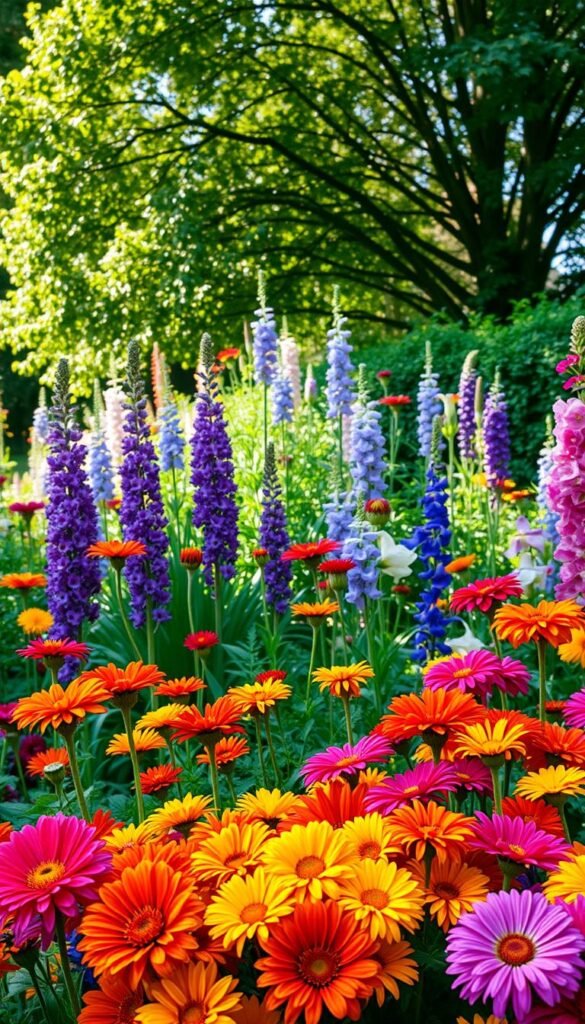Imagine stepping into your backyard to find a living canvas of colors, textures, and fragrances. Unlike traditional landscaping, a flower garden designed for cutting focuses on both beauty and utility. You’ll grow blooms that thrive when trimmed, letting you bring nature’s artistry indoors while keeping plants healthy.
Smart planning makes all the difference. Choosing the right mix of annuals and perennials ensures continuous blooms from spring through fall. Positioning taller plants behind shorter varieties creates depth, while leaving space between beds simplifies maintenance. This approach turns your growing area into a practical yet picturesque sanctuary.
Why settle for ordinary when your outdoor space can serve dual purposes? Thoughtful layouts allow flowers to shine in their natural habitat and in vases on your kitchen table. You’ll discover how staggered planting times extend your harvest window, giving you fresh stems weekly without overwhelming your schedule.
Ready to transform your yard into a dynamic source of joy? Let’s explore how intentional design elevates your gardening experience while creating endless opportunities for creativity.
Welcome to Your Vibrant Flower Garden Adventure
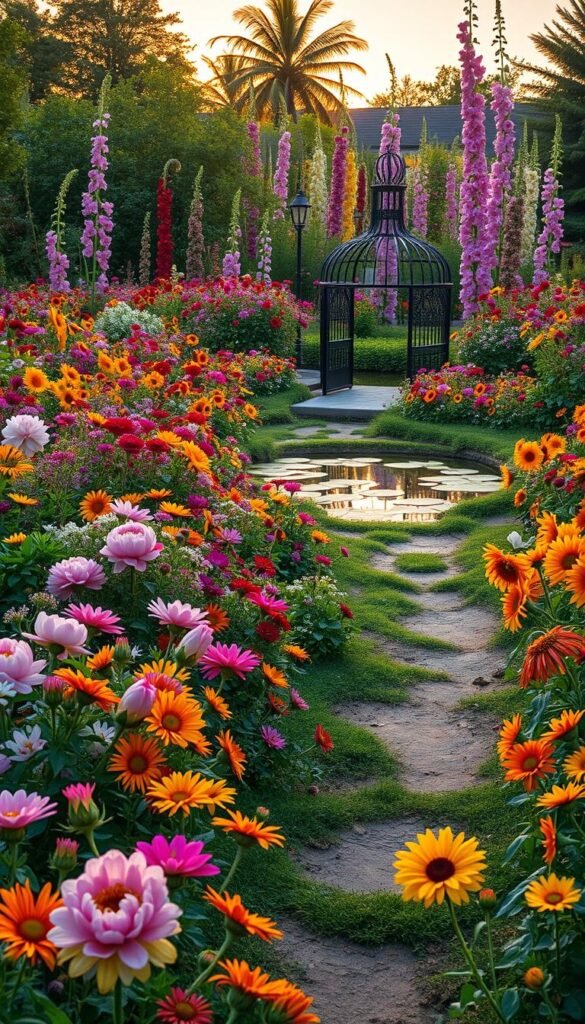
Picture this: a sunlit corner of your yard transformed into a living bouquet that refreshes your home and spirit. Starting a cutting garden might feel overwhelming, but with simple steps, you’ll create a space that thrives through the seasons. Whether you’re growing zinnias for summer arrangements or dahlias for fall displays, every snip brings new energy to your plants and your life.
- Therapeutic benefits of tending plants daily
- Joy in arranging homegrown blooms for your kitchen table
- Seasonal surprises as new varieties emerge each month
Many gardeners find their first successful harvest becomes an addiction. There’s magic in watching seedlings become towering sunflowers or delicate cosmos. Your outdoor space evolves into a sanctuary where stress fades with every bloom you nurture.
Connect with fellow growers through local clubs or online blogs to swap tips and celebrate victories. As your skills grow, so will your confidence to experiment with bold color combinations and unique textures. Before long, you’ll have beds overflowing with enough stems to share with neighbors and friends.
Ready to start? The adventure begins with a single seed – and countless possibilities.
Essential Planning Tips for Your Outdoor Floral Space

Your garden’s success begins with smart organization and the right resources. Taking time to strategize now saves hours of frustration later while boosting your plants’ health and visual appeal.
Gathering Tools and Supplies
Start with durable tools like spades and garden forks that last multiple seasons. Pair these with measuring tapes and graph paper to sketch bed layouts before digging. Collect soil amendments and mulch early – your plants will thank you for the nutrient-rich foundation.
Don’t forget practical items like plant stakes and drip hoses. These prevent overcrowding and ensure consistent hydration during summer heatwaves. Proper preparation lets you focus on growing rather than scrambling for supplies mid-season.
Mapping Out Your Garden Beds
Sketch your outdoor space using simple grid paper templates. Note sunlight patterns and water sources – these determine which flowers thrive where. Leave walking paths between beds for easy access when pruning or harvesting.
Pro tip: Rotate annuals and perennials annually to maintain soil health. Mark planting dates on a calendar to stagger bloom times. This creates waves of color while preventing overwhelming maintenance tasks.
Assessing Your Space and Soil for Maximum Growth

Transform your outdoor area by understanding its natural potential. Successful gardens begin with observing sunlight patterns and testing ground conditions. Start by measuring your available space – a 10×10 bed might surprise you with how many plants it can support.
Evaluating Sunlight and Drainage
Track how light moves across your yard using a sun calculator app. Most flowering varieties need 6+ hours of direct exposure daily. Check for tree roots or structures casting shadows – these create microclimates that affect plant health.
Dig test holes to check drainage. Fill them with water – if they take >4 hours to empty, consider raised beds. Soil testing kits reveal pH levels and nutrient gaps. Amend clay-heavy earth with compost to improve texture and airflow.
Struggling with uneven terrain? Plan around slopes by positioning thirsty plants at lower elevations. Rotate crops annually to prevent soil depletion, and mark seasonal changes in a gardening journal. Your observations today ensure thriving blooms tomorrow.
Designing Garden Beds with Impactful Color and Texture
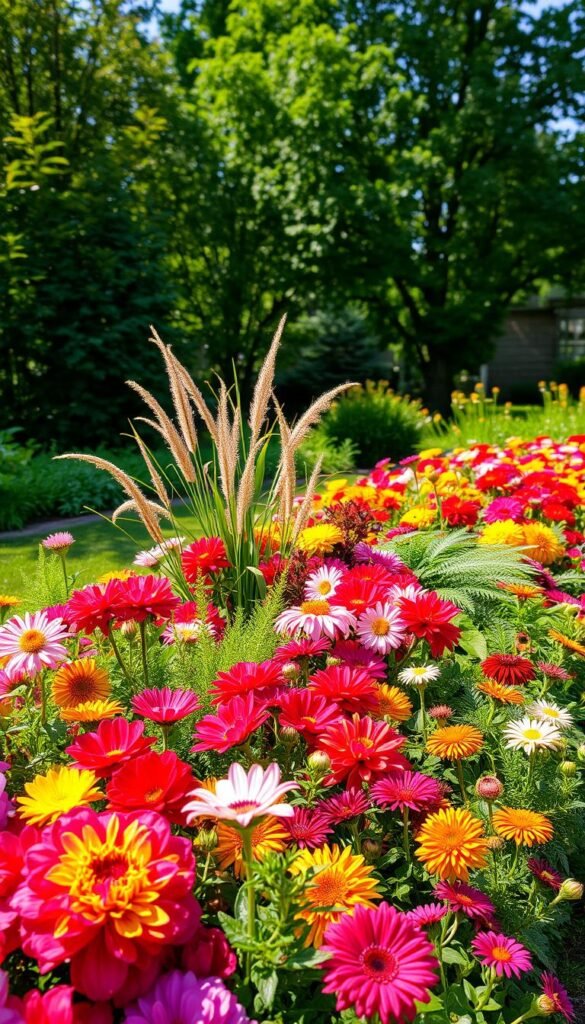
Crafting eye-catching garden beds starts with smart color play and thoughtful texture pairings. Think of your outdoor space as an ever-changing art project where blooms and foliage work together to create drama. A well-planned layout draws the eye through layers of visual interest while feeling cohesive.
Choosing Complementary Blooms
Start with a simple color wheel principle: opposites attract. Pair purple salvias with golden marigolds, or let orange poppies pop against blue delphiniums. These combinations create instant energy in your beds. For subtle elegance, try monochromatic schemes using varying shades of pink or purple.
Mix textures to add depth. Combine feathery cosmos with velvety petunias, or place spiky snapdragons near round zinnias. This contrast keeps your design dynamic yet balanced. Don’t forget foliage – silver-toned artemisia or burgundy heuchera leaves act as natural frame for brighter blooms.
| Color Type | Flower Examples | Design Impact |
|---|---|---|
| Warm Tones | Marigolds, Sunflowers | Creates energy and focal points |
| Cool Tones | Hydrangeas, Irises | Adds calmness and depth |
| Neutral Foliage | Lamb’s Ear, Dusty Miller | Balances bold colors |
Plan for seasonal shifts. Early tulips give way to summer phlox, followed by autumn chrysanthemums. This progression keeps beds lively for months. Use taller plants like hollyhocks as backdrops, then layer medium-height blooms in front for a tiered effect.
Remember: odd numbers work best. Group three or five similar plants together for natural rhythm. Leave space between clusters to let each variety shine. Your beds will feel intentional yet effortlessly vibrant.
Choosing the Ideal Location for Your Garden
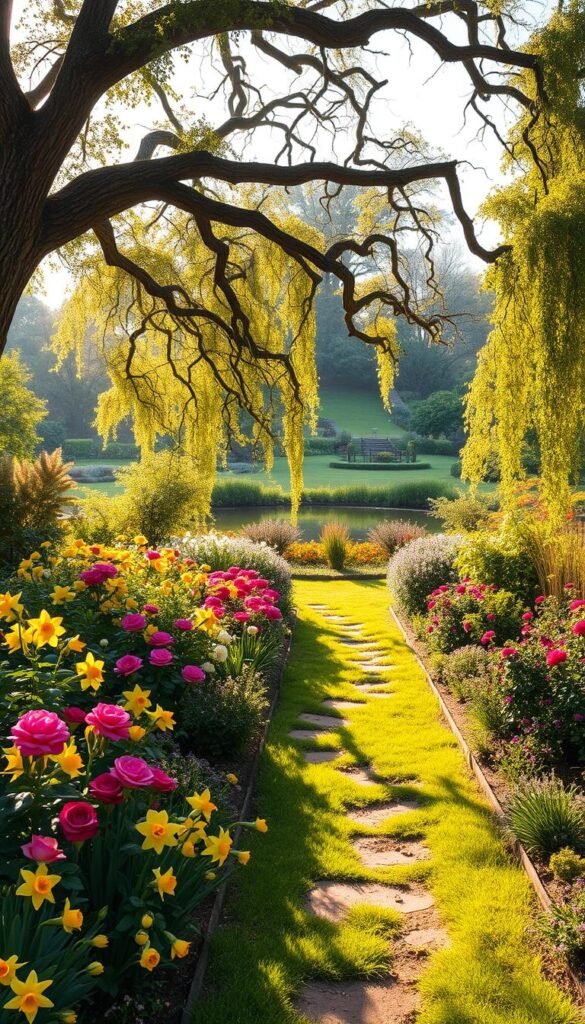
Finding the perfect spot for your blooms starts with understanding your outdoor space’s unique personality. Observe how sunlight dances across your yard at different times – morning rays might favor one corner while afternoon heat claims another. This awareness helps match plants to their ideal conditions.
Sunlight Patterns Made Simple
Most flowering varieties need 6-8 hours of direct light daily. Use free apps like Sun Seeker to track seasonal changes. Notice how shadows from trees or structures shift through the day. Group sun-loving zinnias and cosmos together, while placing shade-tolerant impatiens where light filters through leaves.
Soil quality matters as much as light exposure. Dig test holes to check drainage – if water pools for hours, consider raised bed designs. Compacted earth benefits from compost mixes that improve texture. Avoid areas near mature roots that steal nutrients from your plants.
Practical details make maintenance easier. Position your garden near water sources to simplify hydration. Leave pathways wide enough for wheelbarrows and kneeling pads. Windbreaks like lattice panels protect delicate stems while letting air circulate freely.
Remember: Your landscape isn’t static. What works this year might need tweaking next season as plants grow and light patterns evolve. Keep a journal noting successes and challenges – it becomes your personalized growing guide over time.
10 Fresh Flower Garden Ideas for Vibrant Blooms
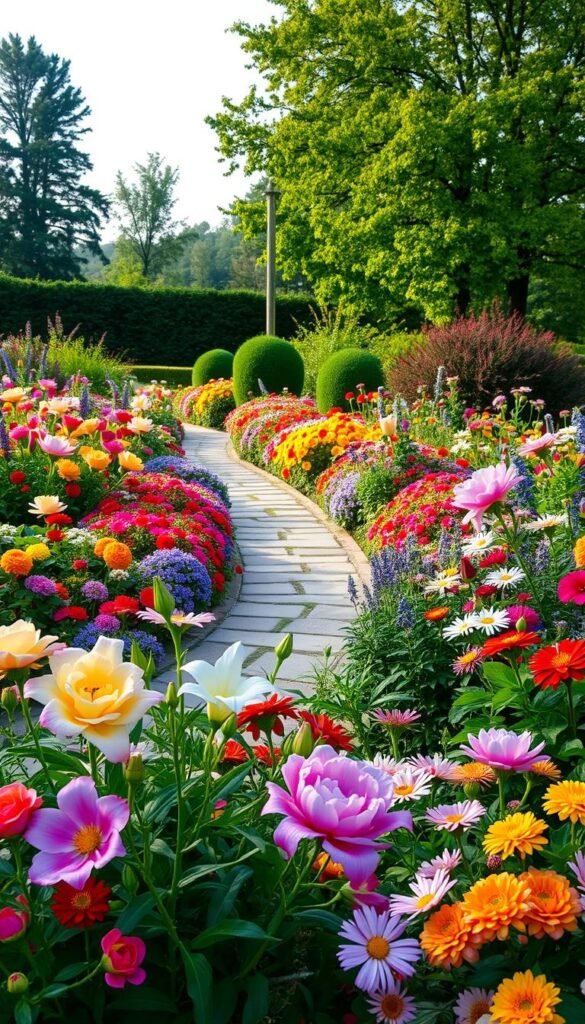
Ever watched butterflies dance around your yard while songbirds serenade your mornings? Transform unused spaces into thriving ecosystems with these creative approaches. Start by crafting a pollinator sanctuary using native species like milkweed and coneflowers – their nectar-rich blooms become nature’s welcome mat for bees and hummingbirds.
For time-strapped growers, drought-resistant plants like lavender and black-eyed Susans offer bold color with minimal effort. “Native varieties practically care for themselves once established,” notes Oregon-based gardener Mia Torres. Pair them with ornamental grasses along fence lines to create living privacy screens that sway gracefully in the breeze.
Elevate your bed designs with strategic layering. Place foxgloves or hollyhocks at the back, mid-height zinnias in the center, and creeping phlox up front. This tiered approach adds depth while showcasing every plant’s best features. For instant curb appeal, frame pathways with fragrant alyssum or line tree bases with cheerful pansies.
Make bold statements by dedicating entire sections to single varieties. A monochromatic rose garden delivers timeless elegance, while a sea of sunflowers radiates pure joy. In shaded corners, combine coleus foliage with impatiens for pops of color that thrive without direct sunlight.
Don’t forget functional beauty. Use repurposed bricks or smooth river rocks to edge your flower beds – these details add polish while preventing soil erosion. Complete your oasis with a cozy bench surrounded by climbing clematis, creating a fragrant retreat for quiet moments.
Incorporating Pollinator-Friendly Plants and Features
Turn your outdoor space into a buzzing sanctuary that supports local ecosystems. By choosing plants tailored to your region’s wildlife, you’ll create habitats while enjoying nature’s daily shows. Start by researching native species that thrive in your climate and soil.
Wildlife-Specific Planting Strategies
Cornflowers become butterfly magnets with their flat, nectar-rich blooms perfect for landing. For hummingbirds, plant tubular salvias – their slender beaks evolved to reach deep into these flowers. Include sunflowers or bee balm to draw diverse pollinators throughout summer.
Design beds with staggered bloom times. Early spring crocuses feed emerging bees, while autumn asters sustain late-season fliers. Cluster similar plants together, creating colorful targets that guide insects efficiently. This approach builds natural highways for pollinators moving through your yard.
Don’t forget shelter elements. Leave some leaf litter under trees for overwintering butterflies. Add shallow water dishes with stones for drinking spots. Your garden transforms into a life-sustaining refuge where every plant serves multiple purposes – beauty meets ecological function.

